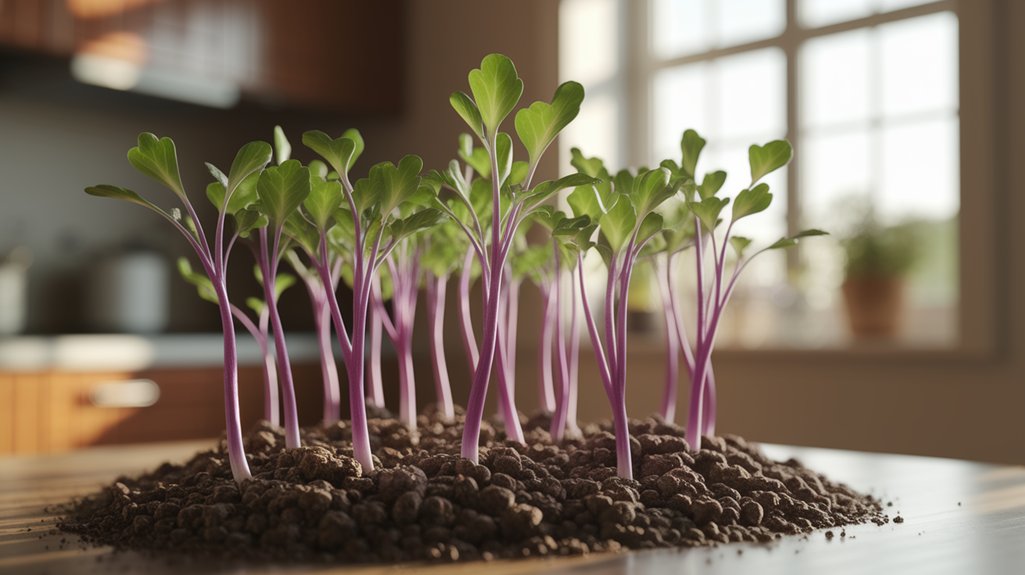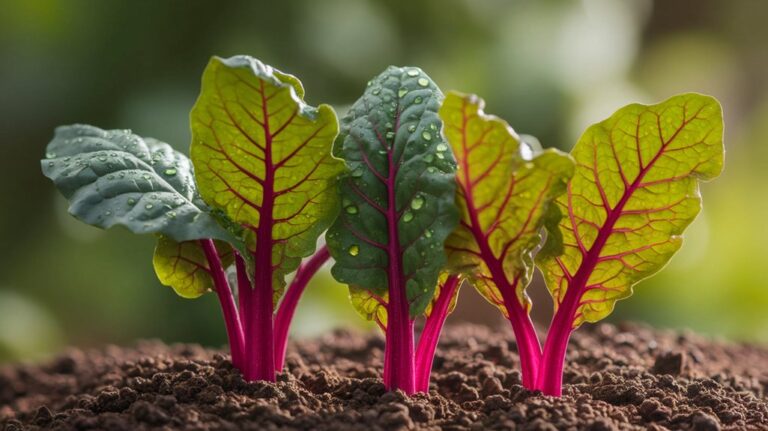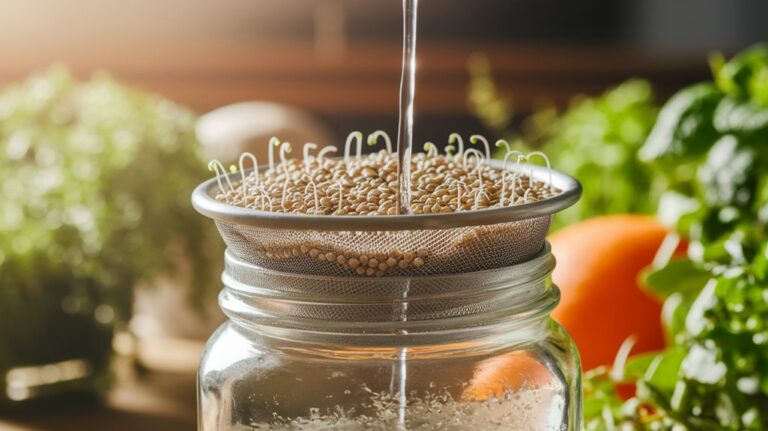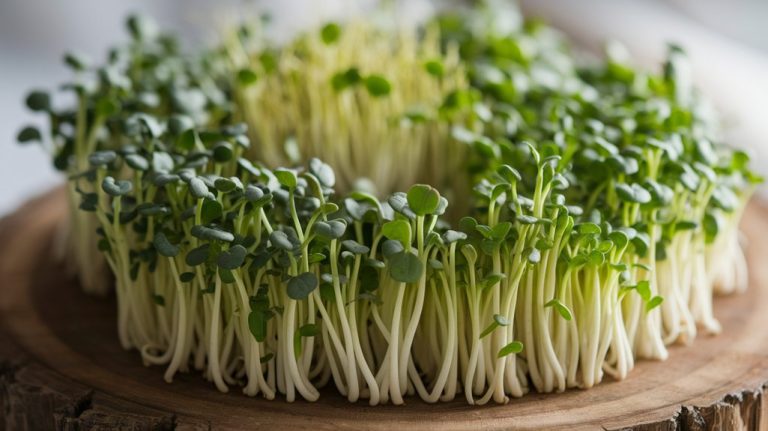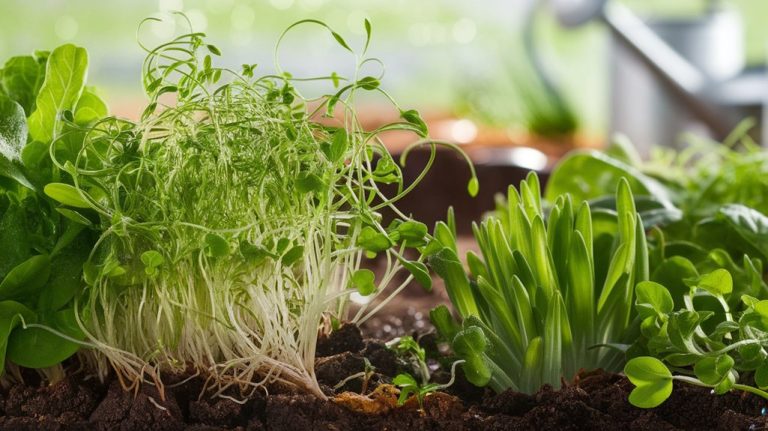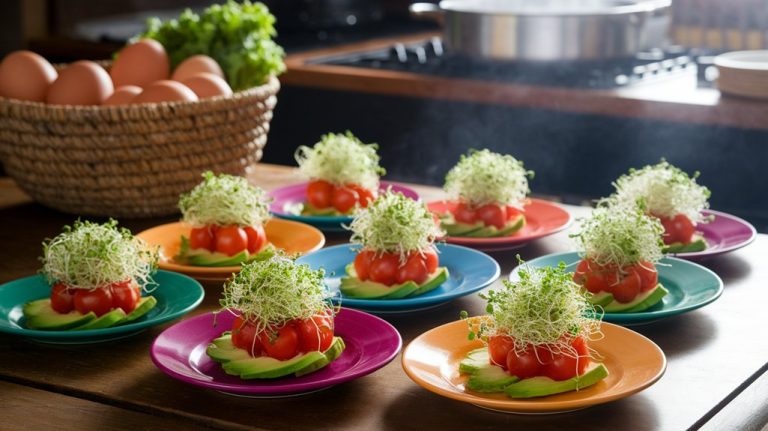How to Sprout Purple Kohlrabi
To sprout purple kohlrabi, I start by choosing a sunny location with well-draining soil. I prepare the soil by loosening it and adding organic matter. Then, I plant seeds about half an inch deep and 6-8 inches apart, ensuring the soil stays moist but not soggy. I keep the temperature between 65-75°F for optimal germination. Regular watering and monitoring for pests are essential as the plants grow. There’s much more to explore about caring for your kohlrabi!
Key Takeaways
- Choose a sunny location with at least six to eight hours of direct sunlight for optimal sprouting conditions.
- Prepare well-draining soil with a pH between 6.0 and 7.0 by adding organic matter like compost.
- Sow purple kohlrabi seeds at a depth of half an inch and space them 6-8 inches apart for proper growth.
- Keep the soil consistently moist, providing about an inch of water weekly for effective germination.
- Ensure regular monitoring for pests and diseases to maintain healthy sprouting and growth.
Understanding Kohlrabi: What Makes It Special
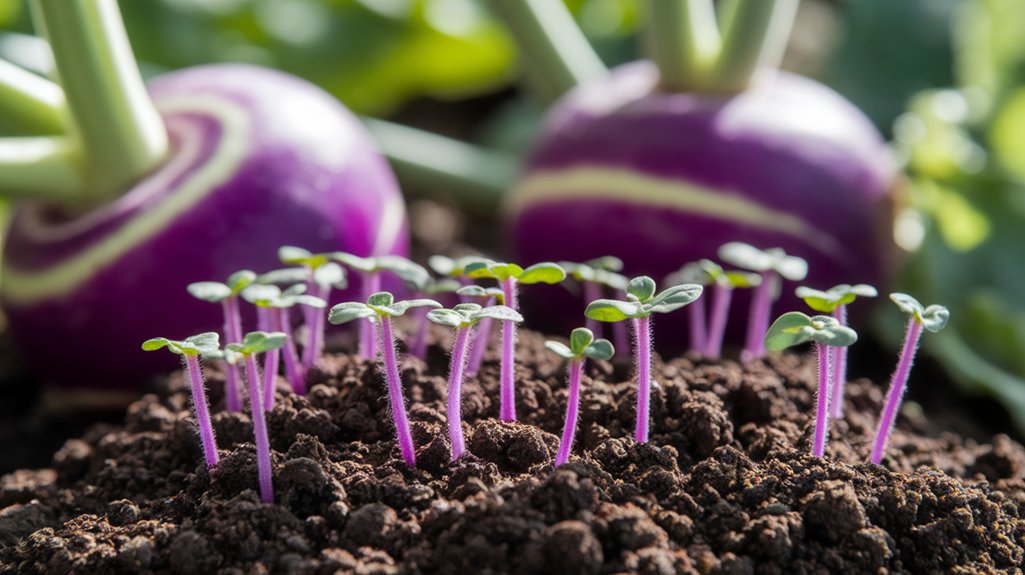
Kohlrabi, often overlooked in the vegetable aisle, stands out for its unique flavor and nutritional profile. This cruciferous vegetable, belonging to the cabbage family, offers a crisp texture and a slightly sweet, peppery taste.
It’s rich in vitamins C and K, providing antioxidants that support immune function and bone health. Additionally, kohlrabi is high in fiber, which aids digestion and helps maintain a healthy weight. Its low-calorie content makes it an excellent choice for those seeking nutritious options.
Furthermore, kohlrabi can be eaten raw or cooked, allowing for versatility in culinary applications. Understanding its distinct characteristics will enhance your appreciation for this underutilized vegetable, paving the way for successful cultivation and consumption in your kitchen.
Choosing the Right Location for Your Kohlrabi
When I plan to grow kohlrabi, I know that choosing the right location is crucial for optimal growth.
Kohlrabi thrives in full sun, so I always select a spot that receives at least six to eight hours of direct sunlight daily. The area should have well-draining soil to prevent waterlogging, which can lead to root rot.
I also consider the proximity to other plants; kohlrabi benefits from companion planting with crops like beans and peas, which can enhance growth. Additionally, I avoid locations exposed to strong winds, as this can damage the fragile leaves.
Preparing the Soil for Planting
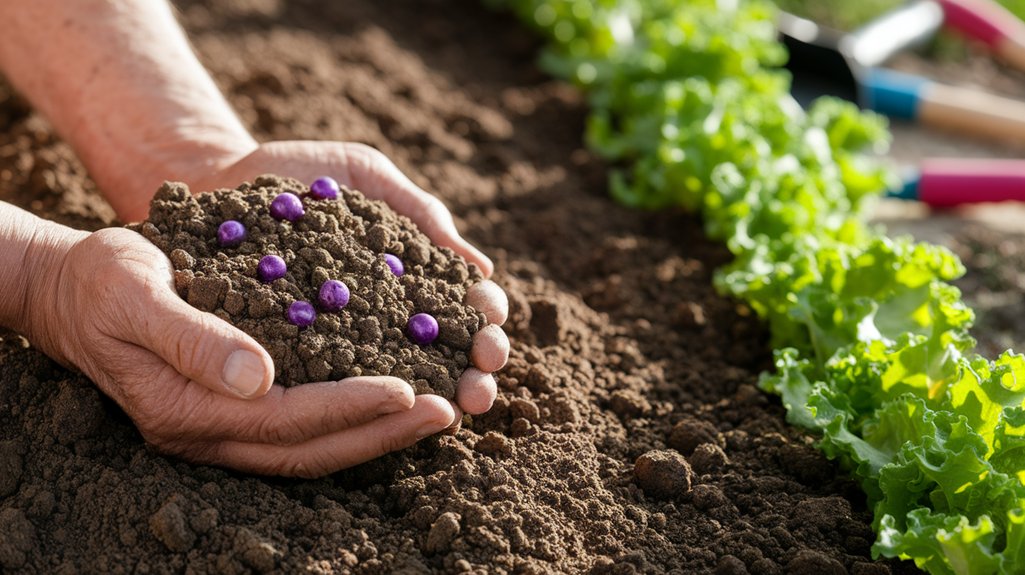
Before planting, I ensure the soil is well-prepared, as this sets the foundation for healthy kohlrabi growth. Proper soil preparation involves several critical steps:
- Test soil pH: I aim for a range of 6.0 to 7.0 for optimal nutrient availability.
- Remove debris: I clear away any weeds, stones, or old plant material to create a clean planting area.
- Loosen the soil: Using a garden fork or tiller, I break up compacted soil to improve aeration and drainage.
- Add organic matter: I incorporate compost or well-rotted manure to enhance soil fertility and structure.
- Level the bed: Ensuring an even surface helps with water distribution and seedling establishment.
These steps are essential for nurturing vigorous kohlrabi plants.
Sowing Kohlrabi Seeds
When I sow kohlrabi seeds, I focus on selecting high-quality seeds to ensure strong growth.
It’s essential to plant them in optimal soil conditions, which support their development.
Additionally, I pay close attention to the ideal planting depth to maximize germination and yield.
Choosing Quality Seeds
Selecting quality seeds is crucial for a successful kohlrabi crop. When I choose seeds, I focus on specific characteristics to ensure a robust harvest.
Here’s what I look for:
- Germination Rate: Higher rates indicate better seed viability.
- Seed Source: I prefer reputable suppliers with good reviews.
- Seed Age: Fresh seeds typically yield better results than older ones.
- Varietal Characteristics: I consider whether I want a specific color or size of kohlrabi.
- Organic Certification: Organic seeds are often free from harmful chemicals, which I find important.
Optimal Soil Conditions
To ensure my purple kohlrabi seeds thrive, I focus on creating optimal soil conditions that promote healthy growth. I aim for well-draining soil rich in organic matter, ideally a loamy texture. The pH should be between 6.0 and 7.0, so I often test my soil beforehand.
Adding compost or well-rotted manure boosts nutrient levels, providing essential elements like nitrogen and potassium. I also ensure the soil is free from weeds, as these can compete for nutrients and moisture.
Moisture retention is crucial, so I incorporate mulch to help regulate soil temperature and moisture levels. By preparing my soil meticulously, I create a supportive environment that encourages robust germination and development for my kohlrabi seeds.
Ideal Planting Depth
The ideal planting depth for sowing purple kohlrabi seeds is about half an inch. This depth ensures that the seeds have enough soil coverage to retain moisture while still being close enough to the surface for germination.
Here are some key points to consider:
- Soil Temperature: Aim for a soil temperature of 65-75°F for optimal germination.
- Seed Spacing: Space seeds about 6-8 inches apart to allow for proper growth.
- Watering: Water gently after sowing to avoid displacing the seeds.
- Sunlight Exposure: Ensure the planting area receives full sunlight for best results.
- Fertilization: Consider light fertilization to provide nutrients without overwhelming young plants.
Caring for Your Kohlrabi Plants
While caring for your kohlrabi plants may seem straightforward, understanding their specific needs can significantly enhance your success.
I’ve found that consistent watering is crucial; kohlrabi thrives with about an inch of water weekly. Make sure the soil remains moist but not soggy, as excessive wetness can lead to rot.
Fertilizing every four to six weeks with a balanced fertilizer promotes healthy growth. I typically apply a nitrogen-rich fertilizer when plants are young, then switch to a balanced mix as they mature.
Additionally, keep an eye out for pests like aphids and caterpillars. I regularly inspect my plants and use organic insecticidal soap if needed.
Lastly, ensure your kohlrabi has adequate sunlight, aiming for 6-8 hours each day.
Harvesting Purple Kohlrabi
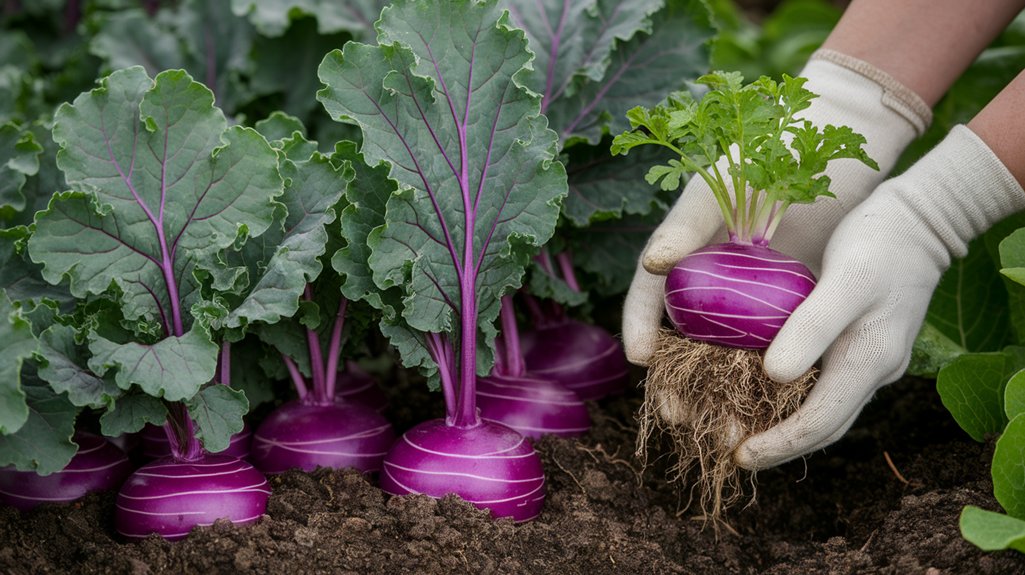
When it comes to harvesting purple kohlrabi, timing is crucial for achieving the best flavor and texture.
I’ll explain the optimal time to harvest and the techniques that ensure a clean and effective process.
Understanding these factors will help you enjoy a successful harvest.
Optimal Harvest Timing
Knowing when to harvest purple kohlrabi is crucial for ensuring optimal flavor and texture. Typically, I aim to harvest my kohlrabi when the bulbs reach about 3-4 inches in diameter.
Here are key indicators to consider:
- Color: Look for a vibrant purple hue; dullness may indicate over-maturity.
- Firmness: Gently squeeze; a firm bulb signals the right time.
- Size: Bulbs larger than 5 inches can become woody and tough.
- Leaves: Healthy, green leaves suggest the plant is still in its prime.
- Days to Maturity: Generally, around 55-70 days post-sowing, depending on the variety.
Harvesting Techniques Explained
To successfully harvest purple kohlrabi, I’ll employ a few straightforward techniques that ensure minimal damage to the plant and maximize the quality of the bulbs. First, I gently grasp the bulb near the base and twist it slightly to loosen the roots. Next, I use a sharp knife to cut the stem about an inch above the bulb. This method prevents bruising and retains the bulb’s freshness.
| Technique | Emotional Impact |
|---|---|
| Gentle Twisting | Reduces anxiety for the plant |
| Sharp Knife Cutting | Ensures confidence in quality |
| Immediate Harvesting | Creates anticipation |
| Clean Environment | Evokes satisfaction |
| Timely Collection | Fosters excitement |
Following these methods, I guarantee a successful harvest every time.
Delicious Ways to Enjoy Kohlrabi
Although many might overlook kohlrabi, I find its crisp texture and slightly sweet flavor make it an excellent addition to a variety of dishes.
Here are some delicious ways I enjoy incorporating kohlrabi into my meals:
- Raw in Salads: I julienne it for a refreshing crunch.
- Stir-Fried: I sauté sliced kohlrabi with garlic and ginger for a flavorful side.
- Mashed: I boil and mash it with potatoes for a creamy blend.
- Pickled: I quick-pickle slices for a tangy snack or topping.
- Roasted: I cube and roast it with olive oil and herbs for a sweet, caramelized treat.
Kohlrabi’s versatility allows me to experiment, ensuring each dish brings out its unique characteristics.
Common Pests and Diseases to Watch For
While tending to my purple kohlrabi plants, I’ve learned that vigilance against pests and diseases is crucial for a healthy harvest.
Common pests include aphids, cabbage worms, and flea beetles. Aphids suck sap, weakening plants, while cabbage worms chew through leaves, causing significant damage. Flea beetles create small holes in the leaves, affecting growth.
In terms of diseases, watch for downy mildew, which manifests as yellowish spots on leaves, and black rot, characterized by blackened veins and wilting.
To combat these issues, I recommend using organic insecticidal soap for pests and practicing crop rotation to prevent disease buildup.
Regularly inspecting your plants and maintaining proper watering and spacing promotes good air circulation, reducing the likelihood of infestations and infections.
Frequently Asked Questions
How Long Does It Take for Purple Kohlrabi to Germinate?
When I plant purple kohlrabi seeds, I usually see germination in about 7 to 14 days, depending on the conditions.
I make sure the soil temperature is between 65°F and 75°F for optimal growth. Consistent moisture is key, so I keep the soil damp but not soggy.
Once I notice those little sprouts breaking through the soil, I know I’m on my way to growing delicious kohlrabi in my garden!
Can I Grow Purple Kohlrabi in Containers?
Absolutely, you can grow purple kohlrabi in containers!
I’ve successfully cultivated them in pots, ensuring they’ve at least 12 inches of depth for proper root development.
I choose a well-draining potting mix and make sure the container gets plenty of sunlight.
Regular watering is essential, but I avoid waterlogged soil.
With some care, I’ve found that kohlrabi thrives in containers, offering a delicious crop even in limited space.
What Temperature Is Ideal for Growing Purple Kohlrabi?
When it comes to growing purple kohlrabi, I’ve found that the ideal temperature ranges between 60°F and 75°F (15°C to 24°C).
It’s crucial to maintain this temperature for optimal germination and growth. If it gets too hot or too cold, I’ve noticed that the plants can become stunted or bolt.
Monitoring the temperature closely has really helped me achieve better yields and healthier plants overall.
How Often Should I Water Purple Kohlrabi Plants?
I usually water my purple kohlrabi plants about once a week, but it really depends on the weather and soil conditions.
I check the top inch of soil; if it feels dry, I give them a good soak. It’s crucial not to overwater, as this can lead to root rot.
Consistent moisture is key, so I keep an eye on them, especially during hot or dry spells.
Is Purple Kohlrabi Frost-Resistant?
Yes, purple kohlrabi is somewhat frost-resistant. I’ve found that it can tolerate light frosts, making it a great choice for cooler climates.
However, if temperatures drop significantly, the growth may slow down, and the quality can diminish. I recommend harvesting before a hard frost hits to ensure the best flavor and texture.
Keeping an eye on the weather helps me protect my crop when those chilly nights approach.
Conclusion
In conclusion, growing purple kohlrabi can be a rewarding experience, offering both aesthetic appeal and nutritional benefits. By choosing the right location, preparing your soil meticulously, and providing proper care, you can cultivate a thriving crop. Don’t forget to monitor for pests and diseases to ensure your plants remain healthy. Once harvested, enjoy the versatility of kohlrabi in various dishes. With a little patience and attention, you’ll be reaping the rewards of your efforts in no time.

